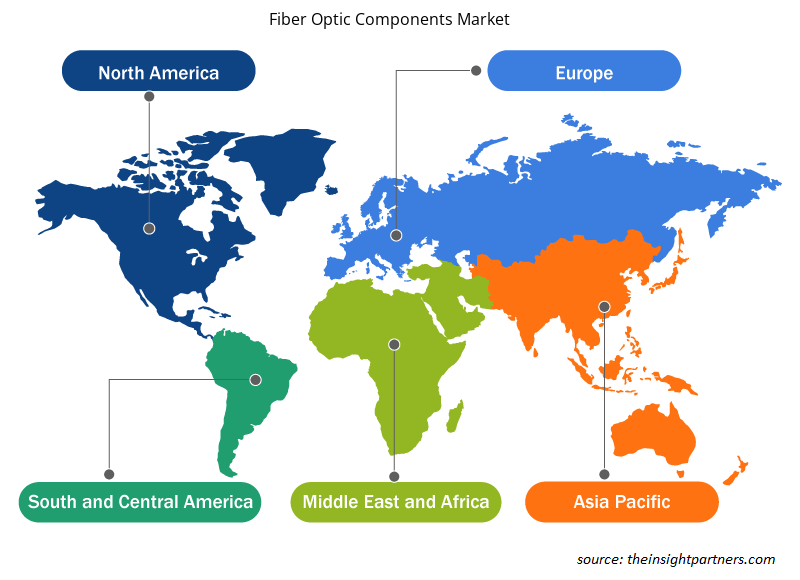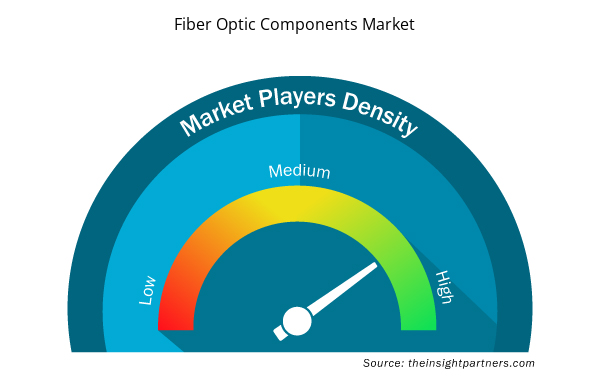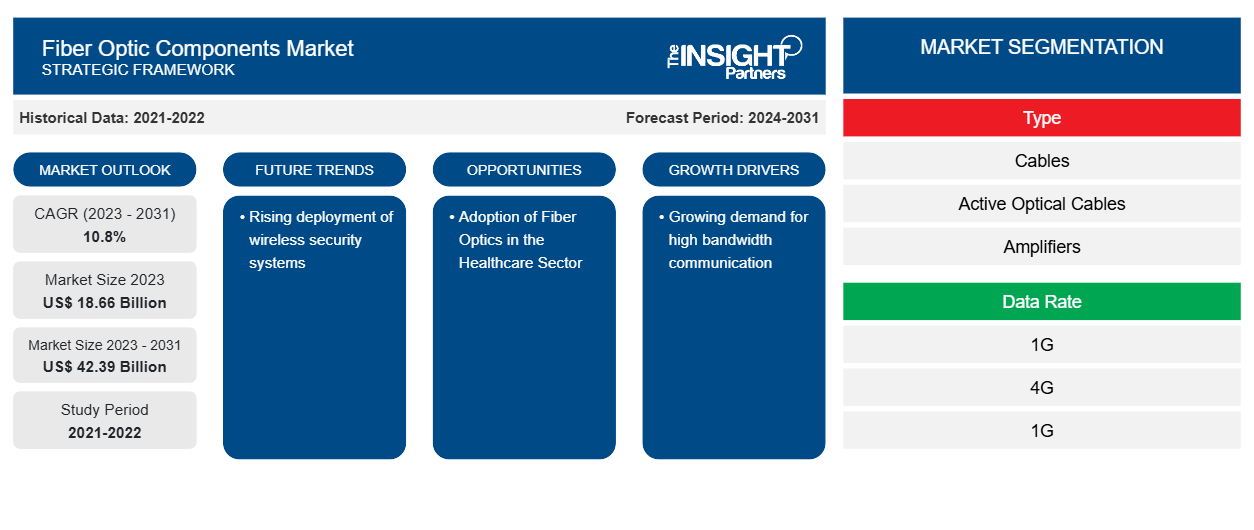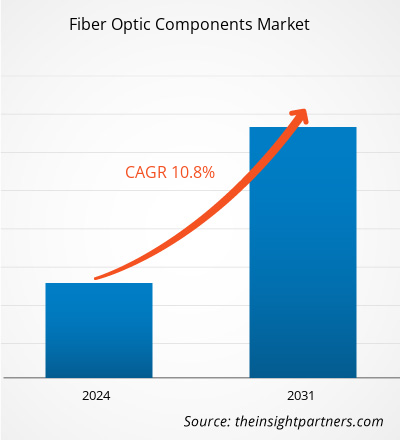Der globale Markt für Glasfaserkomponenten soll von 18,66 Milliarden US-Dollar im Jahr 2023 auf 42,39 Milliarden US-Dollar im Jahr 2031 wachsen; von 2023 bis 2031 wird eine durchschnittliche jährliche Wachstumsrate von 10,8 % erwartet. Der zunehmende Einsatz drahtloser Sicherheitssysteme dürfte weiterhin ein wichtiger Trend auf dem Markt für Glasfaserkomponenten bleiben.CAGR of 10.8% from 2023 to 2031. The rising deployment of wireless security systems is likely to remain key fiber optic components market trends.
Marktanalyse für Glasfaserkomponenten
Das Wachstum dieses Marktes wird durch eine Reihe kommerzieller Gründe vorangetrieben, darunter der verstärkte Einsatz von Rechenzentren, die zunehmende Verbreitung des Internets und des Datenverkehrs, der steigende Bedarf an Bandbreite und Zuverlässigkeit sowie Verbesserungen im Ökosystem der Glasfaserkomponenten.
Marktübersicht für Glasfaserkomponenten
Eine typische Glasfaser besteht aus drei Hauptkomponenten: dem Kern, der das Licht transportiert; dem Mantel, der den Kern mit einem niedrigeren Brechungsindex umgibt und das Licht einschließt; und der Beschichtung, die die empfindliche Faser im Inneren schützt. Der Kern, der das Licht transportiert, ist die kleinste Komponente der Glasfaser. Glasfaserkerne bestehen normalerweise aus Glas, einige sind aus Kunststoff. Der Mantel umgibt den Kern und sorgt für einen niedrigeren Brechungsindex, wodurch die Glasfaser funktioniert. Bei Verwendung eines Glasmantels bestehen Mantel und Kern aus demselben Material auf Siliziumdioxidbasis in einem dauerhaft verschmolzenen Zustand. Die Beschichtung ist die Schutzhülle der Glasfaser. Die Schicht absorbiert Stöße, Kerben, Kratzer und sogar Feuchtigkeit, die den Mantel beschädigen können. Ohne die Beschichtung ist die Glasfaser extrem spröde.
Passen Sie diesen Bericht Ihren Anforderungen an
Sie erhalten kostenlos individuelle Anpassungen an jedem Bericht, einschließlich Teilen dieses Berichts oder einer Analyse auf Länderebene, eines Excel-Datenpakets sowie tolle Angebote und Rabatte für Start-ups und Universitäten.
- Holen Sie sich die wichtigsten Markttrends aus diesem Bericht.Dieses KOSTENLOSE Beispiel umfasst eine Datenanalyse von Markttrends bis hin zu Schätzungen und Prognosen.
Treiber und Chancen auf dem Markt für Glasfaserkomponenten
Steigende Nachfrage nach Breitbandkommunikation begünstigt Markt
Der Bedarf an kabelgebundenem Hochgeschwindigkeitsinternet und Breitbandnetzinfrastrukturen wächst, was wiederum die Nachfrage nach Glasfaserkabeln in die Höhe treibt. Mehrere Faktoren tragen zu diesem Bedarf bei, darunter die Notwendigkeit schneller Internetverbindungen für spezielle Programme wie Spiele, Medien und Videostreaming. Glasfaserleitungen haben eine größere Bandbreitenkapazität und können Daten mit höherer Geschwindigkeit übertragen als Kupferdrähte. Glasfaserkabel haben einen geringeren Signalverlust und sind weniger anfällig für elektromagnetische Störungen, was zu einer zuverlässigeren und robusteren Kommunikation führt.
Einführung von Glasfaser im Gesundheitswesen
Das Gesundheitswesen entwickelt und implementiert ständig neue Technologien, um die Patientenversorgung und die Kommunikation zwischen dem Gesundheitspersonal zu verbessern. Glasfasernetze sind für diesen Wandel von entscheidender Bedeutung, da sie die zuverlässigste und sicherste Konnektivität bieten. Dieser ausführliche Leitfaden befasst sich mit den Vorteilen von Glasfasernetzen im Gesundheitswesen , den Spitzentechnologien, die sie ermöglichen, und der digitalen Revolution der Branche. Das Gesundheitswesen ist ein großer Anwender von Glasfaser-Internet und -Netzwerken. Gesundheitsunternehmen sind auf schnelle, sichere Internetverbindungen angewiesen, um eine schnelle und sichere Übermittlung von Patientendaten zu gewährleisten. Glasfasernetze sind außerdem skalierbarer als herkömmliche Internetverbindungen.scalable than traditional internet connections.
Segmentierungsanalyse des Marktberichts für Glasfaserkomponenten
Wichtige Segmente, die zur Ableitung der Marktanalyse für Glasfaserkomponenten beigetragen haben: Typ, Datenrate und Anwendung.
- Nach Typ ist der Markt in Kabel, aktive optische Kabel (AOC), Verstärker, Splitter, Steckverbinder, Zirkulatoren, Transceiver und andere unterteilt. Das Kabelsegment hatte im Jahr 2023 einen größeren Marktanteil.AOC), amplifiers, splitters, connectors, circulators, transceivers, and others. The cables segment held a larger market share in 2023.
- Basierend auf der Datenrate ist der Markt in 10G, 40G, 100G und über 100G unterteilt. Das 100G-Segment hatte im Jahr 2023 einen größeren Marktanteil.
- Basierend auf der Anwendung ist der Markt in Kommunikation, verteilte Sensorik, analytische und medizinische Geräte sowie Beleuchtung unterteilt. Das Kommunikationssegment hatte im Jahr 2023 einen größeren Marktanteil.
Marktanteilsanalyse für Glasfaserkomponenten nach Geografie
Der geografische Umfang des Marktberichts für Glasfaserkomponenten ist hauptsächlich in fünf Regionen unterteilt: Nordamerika, Asien-Pazifik, Europa, Naher Osten und Afrika sowie Südamerika/Süd- und Mittelamerika. Nordamerika dominierte den Markt für Glasfaserkomponenten im Jahr 2023. Technologische Fortschritte wie der Einsatz von drahtloser Technologie, Cloud-Computing-Plattformen und IoT-basierten Sicherheitssystemen treiben das Wachstum des Marktes für Glasfaserkomponenten voran. Diese Fortschritte verbessern die Effizienz, den Komfort und die Effektivität drahtloser Kommunikationssysteme.IoT-based security systems, are propelling the growth of the fiber optic components market. These advancements improve the efficiency, convenience, and effectiveness of wireless communication systems.
Regionale Einblicke in den Markt für Glasfaserkomponenten
Die regionalen Trends und Faktoren, die den Markt für Glasfaserkomponenten im Prognosezeitraum beeinflussen, wurden von den Analysten von Insight Partners ausführlich erläutert. In diesem Abschnitt werden auch die Marktsegmente und die Geografie für Glasfaserkomponenten in Nordamerika, Europa, im asiatisch-pazifischen Raum, im Nahen Osten und Afrika sowie in Süd- und Mittelamerika erörtert.

- Erhalten Sie regionale Daten zum Markt für Glasfaserkomponenten
Umfang des Marktberichts zu Glasfaserkomponenten
| Berichtsattribut | Details |
|---|---|
| Marktgröße im Jahr 2023 | 18,66 Milliarden US-Dollar |
| Marktgröße bis 2031 | 42,39 Milliarden US-Dollar |
| Globale CAGR (2023 - 2031) | 10,8 % |
| Historische Daten | 2021-2022 |
| Prognosezeitraum | 2024–2031 |
| Abgedeckte Segmente | Nach Typ
|
| Abgedeckte Regionen und Länder | Nordamerika
|
| Marktführer und wichtige Unternehmensprofile |
|
Marktteilnehmerdichte: Der Einfluss auf die Geschäftsdynamik
Der Markt für Glasfaserkomponenten wächst rasant, angetrieben durch die steigende Nachfrage der Endnutzer aufgrund von Faktoren wie sich entwickelnden Verbraucherpräferenzen, technologischen Fortschritten und einem größeren Bewusstsein für die Vorteile des Produkts. Mit steigender Nachfrage erweitern Unternehmen ihr Angebot, entwickeln Innovationen, um die Bedürfnisse der Verbraucher zu erfüllen, und nutzen neue Trends, was das Marktwachstum weiter ankurbelt.
Die Marktteilnehmerdichte bezieht sich auf die Verteilung der Firmen oder Unternehmen, die in einem bestimmten Markt oder einer bestimmten Branche tätig sind. Sie gibt an, wie viele Wettbewerber (Marktteilnehmer) in einem bestimmten Marktraum im Verhältnis zu seiner Größe oder seinem gesamten Marktwert präsent sind.
Die wichtigsten auf dem Markt für Glasfaserkomponenten tätigen Unternehmen sind:
- Accelink Technology Co. Ltd.
- Broadcom, Inc.
- EMCORE Corporation
- Fujitsu Limited
- Furukawa Electric Co. Ltd.
- Kohärent
Haftungsausschluss : Die oben aufgeführten Unternehmen sind nicht in einer bestimmten Reihenfolge aufgeführt.

- Überblick über die wichtigsten Akteure auf dem Markt für Glasfaserkomponenten
Neuigkeiten und aktuelle Entwicklungen zum Markt für Glasfaserkomponenten
Der Markt für Glasfaserkomponenten wird durch die Erhebung qualitativer und quantitativer Daten nach Primär- und Sekundärforschung bewertet, die wichtige Unternehmensveröffentlichungen, Verbandsdaten und Datenbanken umfasst. Im Folgenden finden Sie eine Liste der Entwicklungen auf dem Markt:
- Im September 2023 entwickelte Fujitsu eine optische Übertragungstechnologie, die Daten mit einer Geschwindigkeit von bis zu 1,2 Tbit/s pro optischer Welle liefern kann. Das entspricht der Übertragung der Daten von sechs Blu-ray-Discs (jede mit einer Kapazität von 25 GB) in nur einer Sekunde.
(Quelle: Fujitsu, Pressemitteilung, 2023)
Marktbericht zu Glasfaserkomponenten – Umfang und Ergebnisse
Der Bericht „Marktgröße und Prognose für Glasfaserkomponenten (2021–2031)“ bietet eine detaillierte Analyse des Marktes, die die folgenden Bereiche abdeckt:
- Marktgröße und Prognose auf globaler, regionaler und Länderebene für alle wichtigen Marktsegmente, die im Rahmen des Projekts abgedeckt sind
- Marktdynamik wie Treiber, Beschränkungen und wichtige Chancen
- Wichtige Zukunftstrends
- Detaillierte PEST/Porters Five Forces- und SWOT-Analyse
- Globale und regionale Marktanalyse mit wichtigen Markttrends, wichtigen Akteuren, Vorschriften und aktuellen Marktentwicklungen
- Branchenlandschaft und Wettbewerbsanalyse, einschließlich Marktkonzentration, Heatmap-Analyse, prominenten Akteuren und aktuellen Entwicklungen
- Detaillierte Firmenprofile
- Historische Analyse (2 Jahre), Basisjahr, Prognose (7 Jahre) mit CAGR
- PEST- und SWOT-Analyse
- Marktgröße Wert/Volumen – Global, Regional, Land
- Branche und Wettbewerbsumfeld
- Excel-Datensatz



Report Coverage
Revenue forecast, Company Analysis, Industry landscape, Growth factors, and Trends

Segment Covered
This text is related
to segments covered.

Regional Scope
North America, Europe, Asia Pacific, Middle East & Africa, South & Central America

Country Scope
This text is related
to country scope.
Häufig gestellte Fragen
The global fiber optic components market is expected to reach US$ 42.39 billion by 2031.
The key players holding the majority of shares in the global fiber optic components are Accelink Technology Co. Ltd., Broadcom, Inc., EMCORE Corporation, Fujitsu Limited, and Furukawa Electric Co. Ltd.
The rising deployment of wireless security systems is likely to remain key fiber optic components market trends.
The increasing deployment of data centers, growing internet penetration and data traffic, rising demand for bandwidth and reliability, and developments in the fiber optic components ecosystem are driving the market for fiber optic components.
The fiber optic components market size is expected to grow from US$ 18.66 billion in 2023 to US$ 42.39 billion by 2031; it is anticipated to expand at a CAGR of 10.8% from 2024 to 031.
Trends and growth analysis reports related to Electronics and Semiconductor : READ MORE..
The Insight Partners performs research in 4 major stages: Data Collection & Secondary Research, Primary Research, Data Analysis and Data Triangulation & Final Review.
- Data Collection and Secondary Research:
As a market research and consulting firm operating from a decade, we have published and advised several client across the globe. First step for any study will start with an assessment of currently available data and insights from existing reports. Further, historical and current market information is collected from Investor Presentations, Annual Reports, SEC Filings, etc., and other information related to company’s performance and market positioning are gathered from Paid Databases (Factiva, Hoovers, and Reuters) and various other publications available in public domain.
Several associations trade associates, technical forums, institutes, societies and organization are accessed to gain technical as well as market related insights through their publications such as research papers, blogs and press releases related to the studies are referred to get cues about the market. Further, white papers, journals, magazines, and other news articles published in last 3 years are scrutinized and analyzed to understand the current market trends.
- Primary Research:
The primarily interview analysis comprise of data obtained from industry participants interview and answers to survey questions gathered by in-house primary team.
For primary research, interviews are conducted with industry experts/CEOs/Marketing Managers/VPs/Subject Matter Experts from both demand and supply side to get a 360-degree view of the market. The primary team conducts several interviews based on the complexity of the markets to understand the various market trends and dynamics which makes research more credible and precise.
A typical research interview fulfils the following functions:
- Provides first-hand information on the market size, market trends, growth trends, competitive landscape, and outlook
- Validates and strengthens in-house secondary research findings
- Develops the analysis team’s expertise and market understanding
Primary research involves email interactions and telephone interviews for each market, category, segment, and sub-segment across geographies. The participants who typically take part in such a process include, but are not limited to:
- Industry participants: VPs, business development managers, market intelligence managers and national sales managers
- Outside experts: Valuation experts, research analysts and key opinion leaders specializing in the electronics and semiconductor industry.
Below is the breakup of our primary respondents by company, designation, and region:

Once we receive the confirmation from primary research sources or primary respondents, we finalize the base year market estimation and forecast the data as per the macroeconomic and microeconomic factors assessed during data collection.
- Data Analysis:
Once data is validated through both secondary as well as primary respondents, we finalize the market estimations by hypothesis formulation and factor analysis at regional and country level.
- Macro-Economic Factor Analysis:
We analyse macroeconomic indicators such the gross domestic product (GDP), increase in the demand for goods and services across industries, technological advancement, regional economic growth, governmental policies, the influence of COVID-19, PEST analysis, and other aspects. This analysis aids in setting benchmarks for various nations/regions and approximating market splits. Additionally, the general trend of the aforementioned components aid in determining the market's development possibilities.
- Country Level Data:
Various factors that are especially aligned to the country are taken into account to determine the market size for a certain area and country, including the presence of vendors, such as headquarters and offices, the country's GDP, demand patterns, and industry growth. To comprehend the market dynamics for the nation, a number of growth variables, inhibitors, application areas, and current market trends are researched. The aforementioned elements aid in determining the country's overall market's growth potential.
- Company Profile:
The “Table of Contents” is formulated by listing and analyzing more than 25 - 30 companies operating in the market ecosystem across geographies. However, we profile only 10 companies as a standard practice in our syndicate reports. These 10 companies comprise leading, emerging, and regional players. Nonetheless, our analysis is not restricted to the 10 listed companies, we also analyze other companies present in the market to develop a holistic view and understand the prevailing trends. The “Company Profiles” section in the report covers key facts, business description, products & services, financial information, SWOT analysis, and key developments. The financial information presented is extracted from the annual reports and official documents of the publicly listed companies. Upon collecting the information for the sections of respective companies, we verify them via various primary sources and then compile the data in respective company profiles. The company level information helps us in deriving the base number as well as in forecasting the market size.
- Developing Base Number:
Aggregation of sales statistics (2020-2022) and macro-economic factor, and other secondary and primary research insights are utilized to arrive at base number and related market shares for 2022. The data gaps are identified in this step and relevant market data is analyzed, collected from paid primary interviews or databases. On finalizing the base year market size, forecasts are developed on the basis of macro-economic, industry and market growth factors and company level analysis.
- Data Triangulation and Final Review:
The market findings and base year market size calculations are validated from supply as well as demand side. Demand side validations are based on macro-economic factor analysis and benchmarks for respective regions and countries. In case of supply side validations, revenues of major companies are estimated (in case not available) based on industry benchmark, approximate number of employees, product portfolio, and primary interviews revenues are gathered. Further revenue from target product/service segment is assessed to avoid overshooting of market statistics. In case of heavy deviations between supply and demand side values, all thes steps are repeated to achieve synchronization.
We follow an iterative model, wherein we share our research findings with Subject Matter Experts (SME’s) and Key Opinion Leaders (KOLs) until consensus view of the market is not formulated – this model negates any drastic deviation in the opinions of experts. Only validated and universally acceptable research findings are quoted in our reports.
We have important check points that we use to validate our research findings – which we call – data triangulation, where we validate the information, we generate from secondary sources with primary interviews and then we re-validate with our internal data bases and Subject matter experts. This comprehensive model enables us to deliver high quality, reliable data in shortest possible time.


 Holen Sie sich ein kostenloses Muster für diesen Bericht
Holen Sie sich ein kostenloses Muster für diesen Bericht